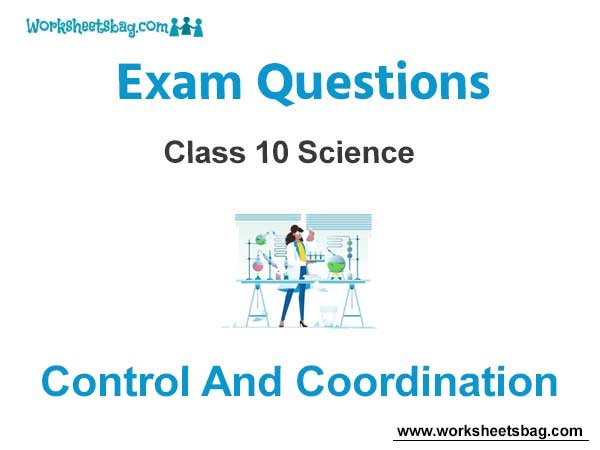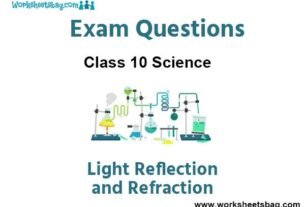Please see Chapter 7 Control and Coordination Exam Questions Class 10 Science below. These important questions with solutions have been prepared based on the latest examination guidelines and syllabus issued by CBSE, NCERT, and KVS. We have provided Class 10 Science Questions and answers for all chapters in your NCERT Book for Class 10 Science. These solved problems for Control and Coordination in Class 10 Science will help you to score more marks in upcoming examinations.
Exam Questions Chapter 7 Control and Coordination Class 10 Science
Multiple Choice Questions
Choose the correct answer from the given options.
Question. A molecule of ammonia (NH3) has
(a) only single bonds
(b) only double bonds
(c) only triple bonds
(d) two double bonds and one single bond
Answer
A
Question. Which of the following is the correct representation of electron dot structure of nitrogen?

Answer
D
Question. Carbon forms four covalent bonds by sharing its four valence electrons with four univalent atoms, e.g. hydrogen. After the formation of four bonds, carbon attains the electronic configuration of
(a) Helium
(b) Neon
(c) Argon
(d) Krypton
Answer
B
Question. The correct electron dot structure of a water molecule is

Answer
C
Question. The molecular formula of ethene and its electron dot structure is

Answer
B
Assertion-Reason Type Questions
For question numbers 1 and 2 two statements are given-one labeled as Assertion (A) and the other labeled Reason (R). Select the correct answer to these questions from the codes (a), (b), (c) and (d) as given below:
(a) Both ‘A’ and ‘R’ are true and ‘R’ is correct explanation of the assertion.
(b) Both ‘A’ and ‘R’ are true but ‘R’ is not correct explanation of the assertion.
(c) ‘A’ is true but ‘R’ is false.
(d) ‘A’ is false but ‘R’ is true.
Question. Assertion: Carbon forms covalent compound with chlorine of formula CCl4.
Reason: Carbon has 4 valence electrons, valency 4, chlorine has 7 valence electrons, valency 1.
Answer
A
Question.Assertion: Carbon forms very large number of compounds.
Reason: It is due to property of catenation and tetravalency
Answer
A
Very Short Answer Type Questions
Question. Give the names of the following functional groups:
(i) —OH (ii) —COOH
Answer. (i) Alcohol group (ii) Carboxylic acid group
Question. Name the carbon compound which on heating with excess of concentrated sulphuric acid at 443 K gives ethene.
Answer.

Question. What is the difference in the molecular formula of any two consecutive members of a homologous series of organic compounds?
Answer. —CH2— is the difference in the molecular formula of any two consecutive members of a homologous series of organic compounds.
Question. What is meant by a saturated hydrocarbon?
Answer. Those hydrocarbons in which valency of carbon is satisfied by single bonds only are called saturated hydrocarbons.
Question. Draw the structure of CH3COOH molecule.
Answer.

Question. Name the compound formed when ethanol is warmed with ethanoic acid in the presence of a few drops of cone.H2S04
Answer.

Question. Draw the structure of ethanol molecule.
Answer.

Question. Carbon has four electrons in its valence shell. How does carbon attain stable electronic configuration.
Answers. By sharing four electrons with other atoms.
Question. What happens when a small piece of sodium is dropped into ethanol?
Answer.

Question. State two characteristic features of carbon which when put together give rise to large number of carbon compounds.
Answer. (i) Catenation (ii) Tetravalency of carbon
Question. How many covalent bonds are there in a molecule of ethane (C2H6)?
Answer. There are 7 covalent bonds in a molecule of ethane.
Question. Write the structural formula of chloroethane.
Answer.

Question. Write the electron dot structure of ethene molecule (C2H4).
Answer.

Question. Draw the structure of butanone molecule, CH3COC2H5.
Answer.

Question. Write the electron dot structure of ethane molecule (C2H6).
Answer.

Short Answer Type Questions
Question. Carbon, group 14 element in the periodic table, is known to form compounds with many elements.
Write an example of a compound formed with (i) Chlorine, (ii) Oxygen.
Answer.

Question. In electron dot structure, the valence shell electrons are represented by crosses or dots.
(i) The atomic number of chlorine is 17. Write its electronic configuration.
(ii) Draw the electron dot structure of chlorine molecule.
Answer.

Question. Compare the ability of catenation of carbon and silicon. Give reasons.
Answer.Carbon shows catenation property to more extent than silicon. It is because C–C bond is stronger than Si–Si bond because carbon is smaller in size than silicon.
Question. Give a test that can be used to confirm the presence of carbon in a compound. With a valency of 4, how is carbon able to attain noble gas configuration in its compounds?
Answer.
– Burn compound in air/ oxygen; Gas evolved turns lime water milky
– By sharing its four valence electrons with other elements.
Question. The number of carbon compounds is more than those formed by all other elements put together. Justify the statement by giving two reasons.
Answer.
• Due to self linking ability of carbon/catenation
• Since carbon has a valency of four it can form bonds with four other atoms of carbon or atoms of some other mono-valent element.
• Due to small size of carbon it forms very strong and (or) stable bonds with other elements
Question. What are covalent compounds? Why are they different from ionic compounds? List their three characteristic properties.
Answer. Those compounds which are formed by equal sharing of electrons are called covalent compounds.
They are different from ionic compounds since ionic compounds are formed by transfer of electrons from one atom to another.
Properties:
(i) They have low melting and boiling points.
(ii) They do not conduct electricity in molten state and in aqueous solution.
(iii) They are mostly insoluble in water but soluble in organic solvents except glucose, sugar, urea, ethyl
alcohol, etc.
Question. (a) Explain why carbon forms covalent bond? Give two reasons for carbon forming a large number of compounds.
(b) Explain the formation of ammonia molecule.
Answer.(a) Carbon has electronic configuration 2, 4. It could gain four electrons forming C-4 anion or lose 4 electrons to form C+4 cation . Both are not possible due to energy considerations. Carbon overcome this problem by sharing electrons and forming covalent compounds. Two reasons for forming large number of compounds:
(1) Catenation (2) Tetra valency
(b) Formation of NH3 molecule
Three hydrogen atoms each share their 1 electron with nitrogen to form three covalent bonds and make an ammonia molecule (NH3).

Question. Carbon, a member of group 14, forms a large number of carbon compounds estimated to be about three million. Why is this property not exhibited by other elements of this group? Explain.
Answer.Carbon shows the property of catenation.
It forms strong covalent bonds with other atoms of carbon forming long straight, branched and closed chain compounds.
Carbon is smallest in size in group 14 with tatravalency, it can form double as well as triple bonds,therefore, it can show property of catenation to maximum extent and forms 3 million compounds other elements cannot show property of catenation to this extent due to larger size form weaker covalent bond and cannot form double or triple bonds.
Question. Atoms of an element contain five electrons in its valence shell. This element is the major component of air. It exists as a diatomic molecule.
(i) Identify the element.
(ii) Show the bond formed between two atoms of this element.
(iii) Write the nature of bond between the two atoms.
Answer.

Question. (i) Explain the formation of calcium chloride with the help of electron dot structure. (At numbers: Ca = 20; Cl = 17)
(ii) Why do ionic compounds not conduct electricity in solid state but conduct electricity in molten and aqueous state?.
Answer.

(ii) Ionic compounds do not conduct in solid state due to absence of free ions but they conduct electricity in molten and aqueous state due to presence of free ions.
ONE MARK QUESTIONS
Question: At the time of puberty, both boys and girls show lots of changes in appearance. Name the hormones responsible for these changes.
Answer: : Testosterone in male and oestrogen in females.
Question: What are hormones?
Answer: Hormones are the chemical substances secreted in trace amounts by specialised tissue called endocrine glands.
Question: Name two tissues that provide control and coordination in multicellular animals.
Answer: (i) Nervous tissue (ii) Endocrine tissue.
Question: What is synapse?
Answer: Synapse is the functional junction between two neurons. It is a gap junction point between nerve endings of one neuron and dendrites of another neuron.
Question: Which mechanism control timing and amount of hormone released?
Answer: Feedback mechanism.
Question: Define‘Chemotropism’.
Answer: Chemotropism is a nastic response towards the chemicals like the germination of pollen tube when pollen grain lands on stigma.
Question: Give one example of chemotropism.
Answer: The growth of pollen tube towards ovule.
Question: Name the plant hormone responsible for the promotion of cell division.
Answer: Cytokinin.
Question: Define ‘reflex action’.
Answer: Reflex action is a sudden, involuntary, spontaneous response to the stimulus that is usually helpful to protect ourselves from any kind of harm.
Question: How is nerve impulses get transmitted across the synapse?
Answer: Neuron ending transmit the nerve impulse to dendrite of next neuron through the chemical (neurotransmitter).
Question: What will happen to a plant shoot if sunlight falls on it from one direction only? What do you call this movement?
Answer: Shoot will bend towards light. Phototropism.
Question: Name the sensory receptors found in the nose and on the tongue.
Answer: Olfactory receptors, gustatory receptors.
Question: How is spinal cord protected?
Answer: Vertebral column made by vertebrae protects the spinal cord.
Question. Draw electron dot structure of NH3 molecule. Predict the total no. of bonds around N-atom.
OR
A molecule of ammonia has the formula NH3. Predict the total number of bonds present around nitrogen atom.
Answer.

It has 3 bonds around N-atom.
Question. Why covalent compounds are poor conductors of electricity?
Answer. It is because covalent compounds do not form ions.
Question. What would be the electron dot structure of carbon dioxide which has the formula, CO2?
Answer.

Question. Which element exhibits the property of catenation to maximum extent and why?
Answer. Carbon since it forms strong covalent bond, due to smaller atomic size.
Question. State two characteristic features of carbon which when put together give rise to large number of carbon compounds.
Answer.(i) Catenation (ii) Tetravalency of carbon.
Question. Explain why carbon generally forms compounds by covalent bonds or do not form ionic compounds.
Or
Give reason why carbon neither forms C4+ cations nor C4– anions but form covalent compounds which are bad conductors of electricity and have low melting and boiling points.
Or
Carbon has four electrons in its valence shell. How does carbon attain stable configuration?
Answer. Carbon as 4 valence electrons. It cannot lose 4 electrons because very high amount of energy is needed. It also cannot gain four electrons because 6 protons cannot hold 10 electrons.
It can share four electrons to form four covalent bonds. Covalent compounds do not conduct electricity because they do not form ions. They have low melting and boiling points due to weak forces of attraction between molecules.
Question. Why are most carbon compounds poor conductors of electricity?
Answer. Carbon compounds form covalent bonds/do not dissociate into ions/do not have charged particles (ions).
Question. Define catenation.
Answer. The property of self-linking of atoms of an element through covalent bonds in order to form straight chain, branched chains or cyclic chains of different sizes is called catenation.
Question.Covalent compounds have low melting and boiling point. Why?
Answer. It is because they have weak van der Waal’s forces of attraction between molecules therefore have low melting and boiling points.
Question. How are covalent bonds formed?
Answer.Covalent bonds are formed by equal sharing of electrons.
TWO MARKS QUESTIONS
Question: (a) Name one gustatory receptor and one olfactory receptor present in human beings.
(b) Write a and b in the given flow chart of neuron through which information travels as an electrical impulse.
Dendrite → a → b→ End point of Neuron
Answer: (a) Tongue / Nose.
(b) a → Cell body, b → axon
Question: Write two differences between the response of the plants and response of the animals to stimuli?
Answer:

Question: Trace the sequences of events through a reflex arc which occur when a bright light is focused on your eyes.
Answer:

Question: What is meant by hydrotropism? Give an example.
Answer:The response of a plant towards water is called hydrotropism. The roots of plants show positive hydrotropism.
Question: Tendrils encircle or coil around the object in contact with it. Elaborate.
Answer: Tendrils are sensitive to touch. When they come in contact with any support, the part of the tendril in contact with the object does not grow as rapidly as the part of the tendril away from the object. This causes the tendril to circle around the object and thus, cling to it.
Question. An aldehyde as well as ketone can be represented by the same molecular formula say C3H6O. Write their structures and name them. State the relationship between two in language of science.
Answer :
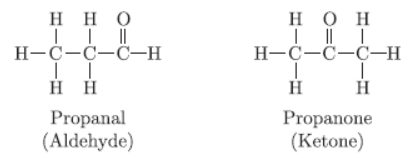
These are functional isomers.
Question. Explain the following reactions with chemical equations:
a. Oxidation
b. Hydrogenation
c. Substitution
Answer :

Question. C3H6, C4H8 and C5H10 belong to same 1 homologous series.
a. Define homologous series.
b. Why the melting and boiling point of C5H10 is higher than C4H3?
c. Arrange these hydrocarbons in order of increasing boiling points.
Answer :
a. The series of organic compounds having same functional group and similar chemical properties is called homologous series.
b. C5H10 has higher molecular mass, more surface area, more van der Waal’s forces of attraction, hence higher boiling point than C4H8.
c. C3H6 < C4H8 < C5H10
Question. Complete the following reactions:
a. CH3COOH + N2CO3 →
b. CH4 + O2 →
c. C2H5OH + Na →
Answer :
a. 2CH3COOH + Na2CO3 → 2CH3COONa + H2O + CO2
b. CH4 + 2O2 → CO2 + 2H2O
c. 2C2H5OH + 2Na → 2C2H5ONa + H2
Question. Two carbon compounds ‘X’ and ‘Y’ have the molecular formula C3H6 and C4H10 respectively. Which one of the two is most likely to show addition reaction? Justify your answer. Also give chemical equation to explain the process of addition in this case.
Answer :
C3H6 will undergo addition reaction because it has double bond.

Question. Complete the following chemical reactions:

Answer :

Question. The molecular formula of two carbon compounds are C4H3 and C3H8. Which one is most likely to show addition reaction? Justify your answer. Also give the chemical equation to explain the process of addition reaction in this case.
Answer : C4H3 will undergo addition reaction. It is because it is unsaturated compound. (question 108)
Question. Write the structural formula of ethanol. What happens when it is heated with excess of conc. H2SO4 at 443 K?
Write the chemical equation for the reaction stating the role of cone. H2SO4 in this reaction.
Answer : (Question 9)
Question. Distinguish between esterification and saponification reaction with the help of equations for each. State one use of each (i) esters and (ii) saponification process.
Answer : Esterification

Esters are used in synthetic flavours, perfumes, etc.
Saponification process is used for manufacture of soaps.
Question. Classify the following carbon compounds into two homologous series and name them.
C3H4, C3H6, C4H6, C4H8, C5H8, C5H10
Answer :
The series of organic compounds having same functional group and similar chemical properties is called homologous series.
Alkene: C3H6, C4H8, C5H10
Alkyne: C3H4, C4H6, C5H3
Question. Write the name and general formula of a chain of hydrocarbons in which an addition reaction with hydrogen is possible. State the essential conditions for an addition reaction. Stating this condition, write a chemical equation giving the name of the reactant and the product of the reaction.
Answer :
Alkenes CnH2n Alkynes CnH2n-2
In above two series of hydrocarbons, addition of H2 is possible.
Hydrogen is added in presence of nickel as catalyst and heating is needed.

Question. What happens when:
(Write chemical equation in each case)
a. Ethanol is burnt in air?
b. Ethanol is heated with excess cone. H2SO4 at 443 K?
c. A piece of sodium is dropped in ethanol.
Answer :

Question. Explain esterification reaction with the help of a chemical equation. Describe an activity to show esterification.
Answer : Esterification is the process in which carboxylic acid reacts with alcohol in presence of conc. H2SO4 to form pleasant fruity smelling compound ester.
Activity:
To carry out esterification reaction.
• Take 2 mL of ethanol (100% alcohol) in a test tube.
• Add 2 mL of glacial acetic acid.
• Add few drops of conc. H2SO4.
• Set the apparatus as shown in diagram.
• Heat the mixture in test tube in water bath for 5 to 10 minutes observe what happens.
• Observation: Pleasant fruity smell is observed.
• Conclusion: Ester is formed.

Question. Name two oxidising agents that are used to convert alcohols to acids. Distinguish between ethanol and ethanoic acid on the basis of (a) litmus test (b) reaction with NaHCO3.
Answer :
These two oxidising agents will convert alcohols to acids (i) Alkaline KMnO4 (ii) Acidified K2Cr2O7
a. Litmus test: Acetic acid turns blue litmus red but ethanol does not.
b. NaHCO3 test: Acetic acid will give brisk effervescence due to evolution of CO2 whereas ethanol will not react.
Question. What are hydrocarbons? Write the general formula of (a) saturated hydrocarbons (b) unsaturated hydrocarbons and draw the structure of one hydrocarbon of each type.
Answer : Hydrocarbons are compounds of carbon and hydrogen only
a. CnH2n+2 is general formula of saturated hydrocarbon. For example, CH4

b. CnH2n(alkenes) and CnH2n-2 (alkynes) are general formulae of unsaturated hydrocarbons. For example,

Question. What is an oxidising agent? What happens when oxidising agent is added to propanol? Explain with the help of a chemical equation.
Answer : Oxidising agent is a substance which adds oxygen or remove hydrogen. Propanol will get oxidised to

Question. The general formula of three compounds A, B and C is Cn (H2n . ‘B’ has highest boiling point and ‘C’ has lowest boiling point.
a. Mention the type of compounds A, B, C.
b. Which of these have minimum number of carbon atoms?
c. Name the homologous series to which A, B and C belong.
Answer :
a. A, B, C are unsaturated compounds.
b. C has minimum number of carbon atoms..
c. They belong to alkene homologous series.
Question. Draw the electron dot structure of ethyne. A mixture of ethyne and oxygen is burnt for welding. In your opinion, why cannot we use a mixture of ethyne and air for this purpose?
Answer :
HC / CH, Ethyne,
Ethyne and oxygen will produce lot of heat on combustion needed for welding whereas ethyne and air will not produce enough heat needed for welding purposes.
Question. What are covalent compounds? Why are they different from ionic compounds? List three characteristic properties.
Answer :
Those compounds in which bonds are formed by sharing of electrons are covalent compounds.
While ionic compounds are formed by complete transfer of electrons.
| Covalent compounds | Ionic compounds | |
| 1. | They have weak intermolecular forces of attraction. | They have strong intermolecular forces of attraction. |
| 2. | They have low melting and boiling points. | They have high melting and boiling points. |
| 3. | They do not conduct electricity. | They conduct electricity in molten state or in aqueous solution. |
Question. When ethanol reacts with ethanoic acid in presence of cone. H2SO4, a substance with fruity smell is produced.
Answer the following questions:
a. State the class of compounds to which fruity smelling compounds belong. Write the chemical equation and write the chemical name of the product formed.
b. State the role of cone. H2SO4 in this reaction.
Answer : a. The fruity smelling compounds are esters

b. Cone. H2SO4 acts as dehydrating agent.
Question. Name the compound formed when ethanol is heated with excess of cone. H2SO4 at 443 K. Also write the chemical equation of the reaction stating the role of cone. H2SO4 in it. What would happen if hydrogen is added to the product in presence of catalyst such as Pd or Ni?
Answer :

Question. Write the chemical equation of the reaction of ethanoic acid with the following:
a. Sodium
b. Sodium hydroxide,
c. Ethanol.
Write the name of one main product of each reaction.
Answer :

Question. Write three different chemical reactions showing the conversion of ethanoic acid to sodium ethanoate.
Write balanced chemical equation in each case. Write the name of the reactants and products other than ethanoic acid and sodium ethanoate in each case.
Answer :

Question. An organic compound ‘P’ is a constituent of wine.
‘P’ on reacting with acidified K2Cr2O7 forms another compound ‘Q’. When a piece of sodium is added to ‘Q’ a gas ‘R’ evolves which burns with a pop sound.
Identify P, Q and R and write the chemical equations of the reactions involved.
Answer :
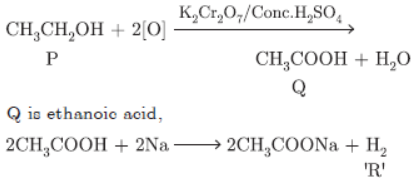
Question. a. Define the term functional group. Identify the functional group present in (Question 124)
b. What happens when 5% alkaline KMnO4 solution is added drop by drop to warm ethanol taken in a test tube? State the role of alkaline KMnO4 solution in this reaction.
Answer : a. Functional group is an atom or group of atoms which determine chemical properties of organic compounds. (a) Aldehyde, (b) Carboxylic acid.
b. Ethanoic acid is formed.

Question. Under which condition an oxidation reaction can be called as combustion reaction. Illustrate your answer with example.
Answer :
When oxidation reaction produces heat as well as light it is called combustion reaction.
CH4 + 2O2 → CO2 + 2H2O + heat + light
It is oxidation as well as combustion reaction.
Question. a. Give chemical tests to detect the presence of (a) ethanol (b) ethanoic acid.
b. Why ethanoic acid is called glacial acetic acid?
Answer :
(i) (a) Ethanol reacts with Na to liberate H2 gas
2CH3CH2OH + 2Na → 2CH3CH2ONa + H2
(b) Ethanoic acid gives brisk effervescence of CO2 with NaHCO3
CH3COOH + NaHCO3 → CH3COONa + H2O + CO2
(ii) It is because pure acetic acid (anhydrous) solidifies into solid crystals just below the room temperature at 16.7°C and look like glacier of snow.
Question. Give reasons for the following observations:
a. The element carbon forms a very large number of compounds.
b. Air holes of a gas burner have to be adjusted when the heated vessels get blackened by the flame.
c. Use of synthetic detergents causes pollution of water.
Answer :
a. It is due to tetravalency of carbon and property of catenation shown by carbon to maximum extent.
b. Air holes must be kept open fully so that complete combustion of fuel takes place producing blue flame.
c. Some of detergents are not bio¬degradable, they create water pollution.
Question. The carbon compounds X and Y have the molecular formula C4H3 and C5H12 respectively. Which one of these is most likely to show addition reaction? Justify your answer. Also give chemical equations to explain the process of addition reaction in this case.
Answer :
C4H3 will undergo addition reaction. It is because it has double bond while C5H12 is a saturated hydrocarbon which cannot undergo addition reaction.

Question. Complete the following equations:
a. CH3COOC2H5 + NaOH →
b. CH3COOH + NaOH →
c. C2H5OH + CH3COOH → Conc.H2SO4
Answer : a. CH3COOC2H5 + NaOH → CH3COONa + C2H5OH
b. CH3COOH + NaOH → CH3COONa + H2O
c. C2H5OH + CH3COOH → Con.H2SO4 CH3COOC2H5 + H2O
Question. a. Why are covalent compounds generally poor conductors of electricity?
b. Name the following compound:

c. Name the gas evolved when ethanoic acid is added to sodium carbonate. How will you test the presence of this gas.
Answer :
a. It is because they do not form ions in their aqueous solution.
b. Propanone
c. Carbon dioxide gas will be liberated. Test: Pass the gas through lime water. If lime water turns milky it shows the presence of CO2 gas.
Question. A compound X on heating with excess of cone. H2SO4 at 443 K gives an unsaturated compound Y. X also reacts with sodium metal to evolve a colourless gas Z. Identify X, Y and Z. Write the equations of the chemical reaction of formation of Y and also write the role of conc. sulphuric acid in the reaction.
Answer :
100. a. Why are most carbon compounds poor conductors of electricity?
b. Write the name and structure of a saturated compound in which carbon atoms are arranged in a ring. Give the number of single bonds present in this compound.
Answer :
a. It is because covalent compounds do not form ions, therefore, do not conduct electricity.
It has 18 single bonds.
Question. Draw the structural formula of all the possible isomers of the compound with the molecular formula C3H6O and also give electron dot structures.
Answer :
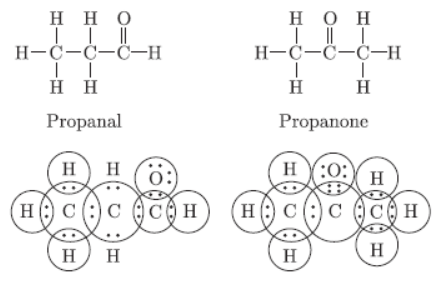
Question. a. Chemical properties of ethanol is different from methyl ethanoate. Justify the statement with proper reason.
b. Methyl ethanoate is used in making perfume.
Justify.
c. Ethanol is converted into ethene when excess of cone. H2SO4 is added. Justify with the help of reaction.
Answer :
a. Chemical properties of a compound depends on its functional group. Ethanol and methyl ethanoate have different functional group thus behave differently. CH3CH2OH has functional group — OH. It has specific smell, reacts with Na metal to liberate H2. CH2COOCH3 has ester (RCOOR’)
as functional group. It has pleasant fruity smell, undergoes saponification reaction with NaOH.
b. It is due to pleasant fruity smell.
c. Conc H2SO4 dehydrates ethanol to ethene.

Question. The structural formula of an ester is

Write the structural formula of the acid and the alcohol from which it might be prepared. Name the process of formation of an ester.
Answer :

Esterification is the process of forming ester
Question. Explain giving reasons, why carbon can neither form C4+ cation nor C4- anion but forms covalent compounds which are bad conductors of electricity and have low melting and boiling points.
Answer : Carbon cannot lose four electrons because high energy is needed to remove four electrons. It cannot gain 4 electrons because 6 protons cannot hold 10 electrons.
It can share 4 electrons to form covalent bonds.
Covalent compounds do not conduct electricity because these do not form ions. They have low melting and boiling points due to weak force of attraction between molecules.
Question. Write the molecular formula of benzene and draw its structure. List in tabular form how covalent compounds differ from ionic compounds.
Answer :

| Covalent compounds | Ionic compounds | |
| 1. | They are bad conductor of electricity. | They are good conductor of electricity. |
| 2. | They have low melting and boiling points. | They have high melting and boiling points. |
Question. Write any three physical properties and three uses of ethanol.
Answer :
Properties
a. Ethanol has specific smell.
b. It is soluble in water.
c. It has burning taste.
Uses
a. It is used as solvent.
b. It is used as an antiseptic.
c. It is used in wine, beer, whisky, etc.
d. It is used for preparation of ethanoic acid, ethyl ethanoate (esters).
Question. Why should we prefer vegetable oils over animal fats for cooking food? Give a balanced chemical equation for reaction of hydrogenation of vegetable oils. Name the catalyst in the reaction.
Answer :
Vegetable oils are unsaturated and do not lead to formation of cholesterol. Animals fats are saturated lead to formation of cholesterol which can be deposited in arteries. (Question 136)
Question. Convert CH4 into CC14 by substituting hydrogen atom with chlorine atom in successive reactions. Why this reaction is referred to as substitution reaction.
Answer :

This reaction is called substitution reaction because hydrogen atom is being substituted by ‘Cl’ in each step.
138. What is difference between the molecule of soaps and detergents, chemically? Explain the cleansing action of soaps.
Answer :
Soaps are sodium or potassium salts of fatty acids.
They contain —COONa group. Detergents are sodium or potassium salts of sulphonic acids. They contains —SO3Na or —SO4Na group. Soap has ionic end which is hydrophilic, interacts with water while carbon chain is hydrophobic interacts with oil, grease. The soap molecules orient themselves in a cluster in which hydrophobic tails are inside the cluster and ionic ends
face outside. These cluster are called micelles. These attract oil which is washed away by water.
Question. What is meant by isomers? Draw the structures of two isomers of butane, C4H10. Explain why we cannot have isomers of first three members of alkane series.
Answer : Isomers are those compounds which have same molecular formula but different structural formula.

Question. Write the molecular formula of the following compounds and draw their electron dot structures:
(a) Ethane (b) Ethene (c) Ethyne
Answer :

Question. Why is homologous series of carbon compounds so called? Write the chemical formula of two consecutive members of any two homologous series and state the part of these compounds that determines their (a) physical and (b) chemical properties.
Answer : Homologous means members of same family that is why series of carbon compounds having same functional group and similar properties is called homologous series.
Homologous series of alcohol.
CH3OH Methanol
C2H5OH Ethanol
CH3— and C2H5— groups determine physical properties and —OH group determines chemical properties. Homologous series of aldehyde.
CH3OH Ethanol
C2H5OH Propanal
Here, CH3—and C2H5— groups determine physical properties while —CHO group determines chemical properties.
Question. What are esters? How are they prepared? List two uses of esters.
Answer :
Esters are pleasant fruity smelling compounds with general formula R—COOR’. They are prepared by reaction of carboxylic acid and alcohol in presence of cone. H2SO4.

Uses
i. They are used in cold drinks and ice creams as synthetic flavours.
ii. They are used in perfumes.
Question. State the meaning of functional group in an organic compound. Write the formula of the functional group present in alcohols, aldehydes, ketones and carboxylic acids.
Answer :
Functional group is an atom or group of atoms which determine chemical properties of organic compounds (a) Aldehyde, (b) Carboxylic acid.

Question. A carboxylic acid (molecular formula C2H4O2) reacts with an alcohol in the presence of an acid catalyst to form a compound X. The alcohol on oxidation with alkaline KMnO4 following by acidification gives the same carboxylic acid C2H4O2. Write the name and structure of (i) carboxylic acid, (ii) alcohol and (iii) the compound ‘X’.
Answer :


Question. What is meant by homologous series of carbon compounds? Write the general formula of (i) alkenes, and (ii) alkynes. Draw the structures of the first member of each series to show the bonding between the two carbon atoms.
Answer :
The series of organic compounds having same functional group and similar chemical properties is called homologous series.

Question. Write the chemical equations to show what happens when
a. an ester reacts with a base?
b. methane is treated with chlorine in the presence of sunlight?
c. ethanol reacts with ethanoic acid in the presence of sulphuric acid?
Answer :

Question. Write the respective chemical equations to show what happens when
a. methane is burned in presence of oxygen?
b. ethanol is heated with concentrated sulphuric acid at 443 K?
c. ethanol reacts with ethanoic acid in the presence of an acid acting as a catalyst?
Answer :

Question. Write chemical equations to describe two different oxidations of ethanol. List two uses of ethanol.
Answer :

Question. A carbon compound X turns blue litmus to red and has a molecular formula C2H4O2. Identify X and draw its structure. Write chemical equation for the reaction and name of the product formed in each case when X reacts with
a. ethanol in the presence of concentrate H2SO4.
b. sodium carbonate.
Answer :

Question. What is meant by isomers? “We cannot have isomers of first three members of alkane series.” Give reason to justify this statement. Draw the structures of two isomers of pentane, C5H12.
Answer : Isomers are those compounds which have same molecular formula but different structural formula.

Question. An ester has the molecular formula C4H8O2. Write its structural formula. What happens when this ester is heated in the presence of sodium hydroxide solution?
Write the balanced chemical equation for the reaction and name the products. What is a saponification reaction.
Answer :

When ester is heated with NaOH, sodium salt of acid and alcohol are formed. It is called saponification reaction.

Question. a. What is meant by a functional group in an organic compound? Name the functional group present in
(1) CH3CH2OH
(2) CH3COOH
b. State one point of difference between soap and synthetic detergent.
Answer :
a. Functional group is an atom or group of atoms which determine chemical properties of organic compounds. (1) Alcohol, (2) Carboxylic acid.
a. Soaps do not work well with hard water as form insoluble scum whereas detergents work well with hard water.
